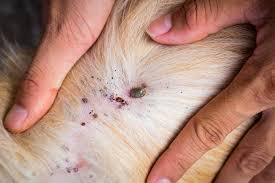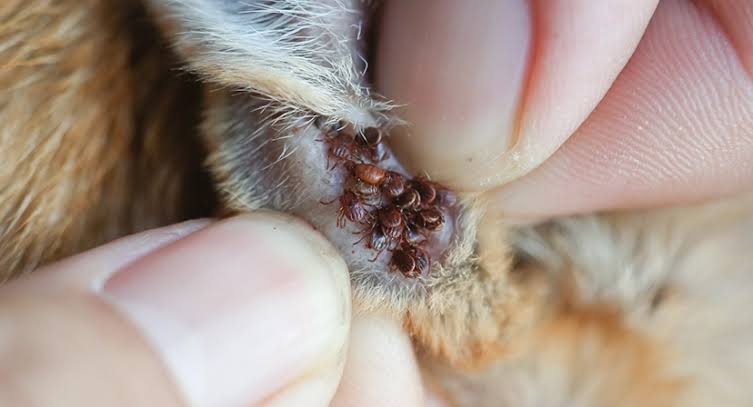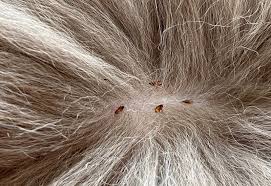Fleas, scientifically known as Siphonaptera, are tiny insects that often cause discomfort to both humans and animals. These minuscule creatures, measuring only a few millimeters in size, are adept at jumping great distances relative to their size. Despite their small stature, fleas have been a persistent nuisance throughout history, as they feed on the blood of their hosts.
These bothersome insects typically infest furry animals like dogs and cats, finding refuge in their fur and causing incessant itching. Fleas possess specialized mouthparts designed for piercing the skin of their host and siphoning blood. This feeding behavior not only irritates the host but can also lead to various health issues, including skin infections and allergic reactions.
The life cycle of fleas consists of four stages: egg, larva, pupa, and adult. Flea eggs are laid on the host or in the surrounding environment and, once hatched, the larvae feed on organic debris. After undergoing pupation, adult fleas emerge and seek a host for blood-feeding. The entire life cycle can be completed in as little as a few weeks, contributing to rapid infestations if not properly addressed.
Fleas are known vectors of various diseases, both for animals and humans. They can transmit pathogens such as bacteria and viruses through their feeding activities. Additionally, flea bites can cause discomfort and itching, leading to secondary infections if scratched excessively.
Controlling flea infestations requires a comprehensive approach. Regular grooming of pets, washing their bedding, and using flea prevention products are crucial measures. In households with a flea problem, thorough cleaning of living spaces, including vacuuming carpets and treating outdoor areas, is essential to break the life cycle and prevent reinfestation.
Despite their nuisance, fleas have not gone unnoticed in the natural world. Some species of ants, beetles, and nematodes act as natural predators of fleas, helping to maintain a balance in the ecosystem. Understanding the biology and behavior of fleas is key to effective management and prevention, ensuring a healthier and more comfortable living environment for both pets and their owners.
Read Also: Exotic Shorthair Cat Breeds Description and Complete Care Guide
Animals Affected by Fleas (Siphonaptera)

Fleas are notorious for infesting a variety of animals, causing discomfort and health issues. Commonly affected animals include mammals, particularly domestic pets such as dogs and cats. These tiny insects, belonging to the order Siphonaptera, feed on the blood of their hosts, leading to a range of problems for the affected animals.
1. Dogs and Cats: Fleas often infest the fur of dogs and cats, causing intense itching, redness, and skin irritation. Some animals may develop allergic reactions to flea saliva, leading to conditions like flea allergy dermatitis. If left untreated, severe flea infestations can result in anemia, especially in small or young animals.
2. Wild Animals: Various wild mammals, including raccoons, rabbits, and rodents, can also fall victim to fleas. The pests thrive in outdoor environments and can easily transfer from one host to another in natural habitats.
3. Livestock: While less common, livestock animals such as cows and horses can also be affected by fleas. Fleas may contribute to stress and discomfort in these animals, affecting their overall well-being.
4. Birds: Certain types of fleas target birds as their hosts. Avian fleas can infest the feathers and skin of birds, causing irritation and negatively impacting their health. This is particularly relevant for poultry and pet birds.
5. Humans: Although humans are not the primary hosts for fleas, these pests can bite and cause discomfort. Flea bites on humans are often itchy and can result in skin irritation. However, fleas usually prefer animals over humans for their blood meals.
Effective flea control for animals involves regular grooming, use of flea prevention products, and maintaining a clean living environment. Treating both the animals and their surroundings is crucial to breaking the flea life cycle and preventing reinfestation. Regular veterinary care and consultation are essential for managing flea-related issues in pets and other animals.
Damages Caused by Fleas

Fleas can inflict various damages, both directly and indirectly, on their hosts and their surrounding environment. Here are some of the key damages caused by fleas:
1. Skin Irritation: Flea bites can lead to skin irritation in their hosts. The bites typically cause redness, itching, and swelling. In severe cases, repeated scratching can result in open sores, increasing the risk of secondary bacterial infections.
2. Allergic Reactions: Some animals and humans may be allergic to flea saliva. Flea allergy dermatitis (FAD) is a common allergic reaction characterized by intense itching, hair loss, and inflamed skin. Continuous exposure to fleas can exacerbate allergic reactions.
3. Anemia: Severe flea infestations, especially in young or small animals, can lead to anemia. Fleas feed on the blood of their hosts, and constant blood loss can result in a decrease in red blood cell count, causing weakness and lethargy in affected animals.
4. Transmission of Diseases: Fleas can act as vectors for various diseases. They may carry and transmit pathogens, such as bacteria and parasites, to their hosts. This can lead to illnesses ranging from bacterial infections to more serious diseases like typhus and Bartonella.
5. Stress and Discomfort: The constant irritation caused by fleas can lead to stress in animals. Infested pets may exhibit changes in behavior, decreased appetite, and restlessness due to the discomfort caused by flea bites.
6. Environmental Impact: Fleas can disrupt the balance of ecosystems. Excessive scratching by infested animals may disturb soil and vegetation, affecting the environment. Additionally, the use of chemical pesticides to control fleas can have unintended consequences on non-target organisms.
7. Spread to Other Animals: Fleas are highly mobile and can easily transfer from one host to another. Infested animals can spread fleas to their surroundings, increasing the risk of flea infestations in the area.
Effective flea control involves a holistic approach, addressing both the affected animals and their environment. Regular grooming, use of flea prevention products, and maintaining clean living spaces are essential measures to mitigate the damages caused by fleas. Seeking veterinary advice and timely intervention can prevent long-term health issues in infested animals.
Read Also: Tonkinese Cat Breed (Felis catus) Description and Complete Care Guide
Control and Preventive Measures

Controlling and preventing flea infestations involves a combination of measures targeting both the affected animals and their environment. Here are key control and preventive measures:
1. Regular Grooming: Regular grooming of pets is crucial to inspect for fleas and remove them promptly. Use a flea comb to comb through the fur, paying attention to areas where fleas commonly hide, such as around the neck and base of the tail.
2. Flea Preventive Products: Use veterinary-approved flea preventive products, such as spot-on treatments, oral medications, or flea collars, as directed by a veterinarian. These products help protect animals from fleas and can also aid in controlling existing infestations.
3. Clean Living Spaces: Regularly clean and vacuum living spaces, especially areas where pets spend time. Pay attention to carpets, furniture, and bedding. Dispose of the vacuum bag or empty the canister outside to prevent fleas from reinfesting the indoor environment.
4. Wash Bedding and Linens: Wash pet bedding, blankets, and other linens regularly in hot water. This helps eliminate flea eggs, larvae, and adults that may be present in these items.
5. Yard Maintenance: Keep outdoor areas tidy by mowing the lawn and removing debris where fleas might thrive. Consider using pet-safe outdoor flea control products, such as insecticidal sprays or nematodes, to reduce flea populations in the yard.
6. Environmental Treatments: In severe infestations, consider professional pest control services to treat the environment. This may involve the application of insecticides to targeted areas, such as cracks and crevices where fleas hide.
7. Regular Veterinary Check-ups: Schedule regular veterinary check-ups for pets. Veterinarians can provide guidance on flea prevention, recommend appropriate products, and address any health issues resulting from flea infestations.
8. Treat All Pets: If a household has multiple pets, ensure that all animals are treated for fleas simultaneously. Treating only one pet may leave others at risk of infestation.
9. Natural Predators: Encourage natural flea predators, such as certain species of nematodes and predatory beetles, in outdoor spaces. These organisms can help control flea populations naturally.
10. Educate Pet Owners: Pet owners should be educated about the importance of flea prevention and control. Providing information on the signs of flea infestations and the proper use of preventive measures can contribute to effective management.
Implementing a comprehensive approach that combines these measures is key to successfully controlling fleas and preventing reinfestations. Regular monitoring and early intervention are essential components of effective flea management.
Frequently Asked Questions (FAQs) About Fleas (Siphonaptera)
1. Q: Can fleas infest humans?
A: While humans are not the primary hosts for fleas, they can still be bitten, causing discomfort and itching. Fleas prefer animals for their blood meals, but in the absence of animal hosts, they may bite humans.
2. Q: How do I know if my pet has fleas?
A: Signs of fleas in pets include excessive scratching, red and irritated skin, hair loss (especially around the base of the tail), and the presence of small black specks (flea dirt) in the fur.
3. Q: Can fleas transmit diseases to pets or humans?
A: Yes, fleas can transmit diseases. They can carry and transmit various pathogens, including bacteria and parasites, which can lead to illnesses in both animals and humans.
4. Q: What is flea allergy dermatitis (FAD)?
A: Flea allergy dermatitis is an allergic reaction to proteins in flea saliva. Pets with FAD experience intense itching, hair loss, and inflamed skin. It’s crucial to address fleas promptly to manage and prevent this condition.
5. Q: How do I treat my home for fleas?
A: To treat your home for fleas, focus on thorough cleaning. Vacuum carpets, wash bedding, and use insecticidal sprays or flea control products in targeted areas. Professional pest control services may be needed in severe infestations.
6. Q: Can fleas infest outdoor areas?
A: Yes, fleas can infest outdoor areas, especially in environments where animals with fleas frequent. Regular yard maintenance, use of outdoor flea control products, and proper waste disposal can help prevent outdoor flea infestations.
7. Q: Are there natural ways to control fleas?
A: Yes, natural methods include using nematodes, diatomaceous earth, and certain essential oils. However, effectiveness may vary, and it’s essential to consult with a veterinarian before using these methods, especially with pets.
8. Q: How often should I use flea prevention products on my pet?
A: The frequency of flea prevention product use depends on the specific product and the pet’s lifestyle. Consult with a veterinarian to determine the most suitable preventive measures and their application schedule.
9. Q: Can I get rid of fleas without using chemicals?
A: While natural methods exist, severe infestations may require chemical interventions. Consult with a veterinarian to explore safe and effective options for flea control, considering the severity of the infestation and the well-being of the pets.
10. Q: What should I do if my pet has a severe flea infestation?
A: Seek veterinary advice promptly. Veterinarians can recommend appropriate treatment options, address potential health issues, and guide you on preventing future infestations. Early intervention is crucial for managing severe flea problems.
Read Also: Hydroponics Guide 101: All You Need to Know About it
